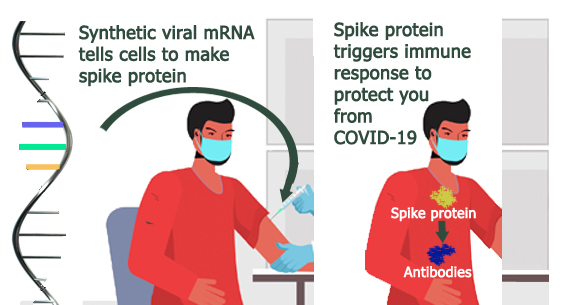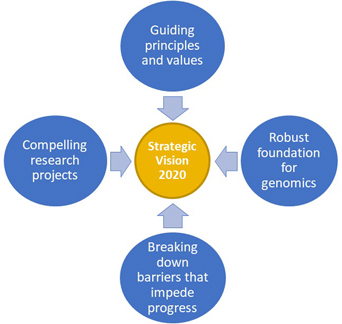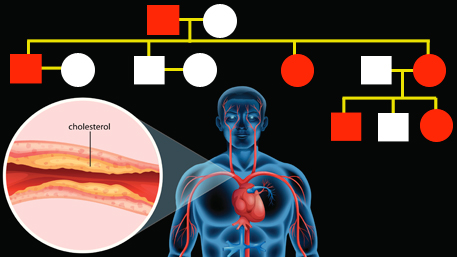Search Results
10 results for rare disease
Host Genomics and COVID-19: One Year Later

Unprecedented global research collaborations in human genomics provide a model for research in response to a pandemic. Early in the COVID-19 pandemic, we discussed the role of research on human genetics in the investigation of SARS-CoV-2 infection and outcomes. We now know more about the wide variation in host response, from asymptomatic infection to
Posted on bymRNA COVID-19 Vaccines: An Incredible Feat of Genomic Technology

In December 2020, less than a year after the SARS-CoV-2 virus was identified, two COVID-19 vaccines manufactured by Pfizer-BioNTech and Moderna were approved for use in the United States under an Emergency Use Authorization by the U.S. Food and Drug Administration (FDA). Never has a U.S. vaccine been developed so quickly, and genome technology made
Posted on by 2 CommentsHow Common is Familial Hypercholesterolemia?

Familial Hypercholesterolemia (FH) is a genetic condition that leads to high blood levels of low-density lipoprotein cholesterol, also known as LDL-C or “bad cholesterol.” Most people with FH have heterozygous FH, meaning they have only one FH-causing mutation, but in rare cases, a person can have homozygous FH, meaning they have FH-causing mutations in both
Posted on byNext Generation Sequencing to Diagnose Primary Immunodeficiency

Primary immunodeficiencies (PI) are a group of more than 400 genetic disorders that alter the ability of the immune system to fight off infection and affect 1 out of 1,2001 births in the United States. Patients with PI are at increased risk of recurrent infections, certain malignancies, and death. Initial identification of PI in a
Posted on byA New Vision for Using Genomics to Improve Health: An Expanded Role for Public Health

The National Human Genome Research Institute (NHGRI) recently published a new strategic vision 2020 to identify research priorities and opportunities in human genomics for improving health. The framework includes four main areas: guiding principles and values, a robust foundation for genomics, breaking down barriers that impede progress, and compelling research projects. Since the completion of
Posted on by 1 CommentGenome-wide Association studies (GWAS) in the Quest to Understand the Causes of Birth Defects

Our recent review and commentary found that relatively few genome-wide association studies (GWAS) on structural birth defects have been done, compared with the number of GWAS on other conditions. We reviewed the literature to identify GWAS on oral clefts, congenital heart defects (CHDs), biliary atresia, pyloric stenosis, hypospadias, craniosynostosis, and clubfoot. We did not find
Posted on byPublic Health Perspectives on Ensuring Life Long Benefits of Newborn Screening

This blog post is a summary of a Perspective recently published in Pediatrics that was authored by Alex Kemper of Nationwide Children’s Hospital, Jeffrey Brosco of the Miller School of Medicine, University of Miami, and Coleen Boyle and Scott Grosse of CDC’s National Center on Birth Defects and Developmental Disabilities. Newborn screening is a highly
Posted on byWhy should early career public health researchers pay attention to precision medicine?

In a recent commentary published in the American Journal of Public Health, I had the privilege of working with a group of early career investigators to begin a conversation about the impact that the debate between the utility of precision medicine and public health approaches is having as we begin our research careers. To begin, let’s
Posted on byPerspectives from a state genetics coordinator: Public health’s role in addressing familial hypercholesterolemia (FH) in the United States

For several years I have pondered what should or could be the state public health agency role in addressing FH. Most of my public health genetics colleagues were actively working on other CDC-labeled tier 1 conditions, such as Lynch syndrome (LS) and Hereditary Breast and Ovarian Cancer syndrome (HBOC). While few, if any, of my
Posted on byPublic Health is Striving Towards More Precision

In the past few years, the term “precision medicine” has become firmly established in the modern biomedical research enterprise. More recently, the term “precision” has made its way to the realm of public health. We and others have contributed to the discourse on precision public health and its relation to precision medicine. But not everyone
Posted on by